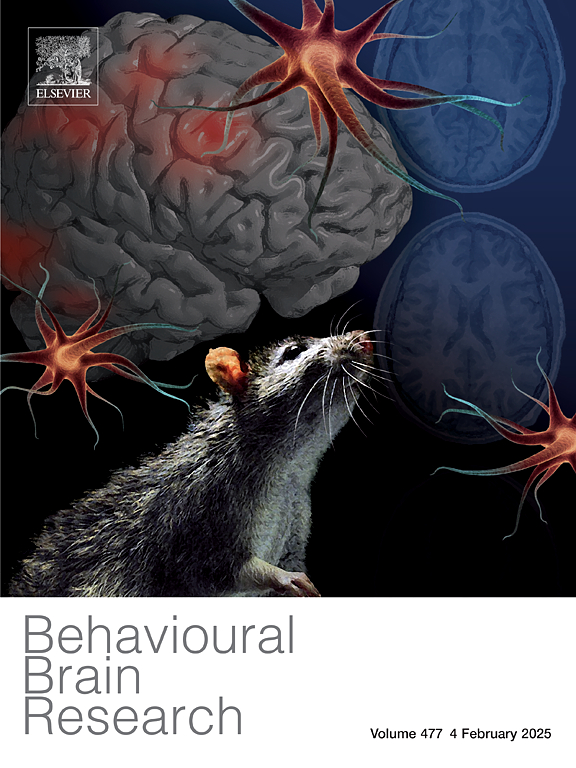Adolescent CB1 receptor expression at the BLA and CA1 and acute AM251 effects on sociability and emotional memory are sex-specific, and not modulated by heterotypic stress exposure
IF 2.3
3区 心理学
Q2 BEHAVIORAL SCIENCES
引用次数: 0
Abstract
Blockade of endocannabinoid CB1R has shown effects on adulthood sociability, memory and fear responses, under basal and stress conditions. In this study, we examined sex-specific effects of exposure to heterotypic stress in the prepubescent period, marked by maturation of brain systems, on endocannabinoid receptors expression, corticosterone secretion and effects of CB1 receptor blockade on social and cognitive responses. Sixty-four (N = 32 per sex) adolescent male and female rats were randomly assigned to a stress or no stress condition. Rats in the stress condition underwent a 10-day heterotypic stress paradigm alternating between restraint stress and forced swim exposure occurring between postnatal day (PND) 30 and PND39. On PND42 and PND44, rats pretreated with the cannabinoid 1 receptor (CB1) antagonist AM251 (1 mg/kg; i.p.) or a vehicle solution underwent behavioural testing in the social interaction and the Y-Maze passive avoidance tests. Our findings indicated acute CB1 antagonism to reduce sociability and fear memory, independently of sex or stress. Notably, baseline and stress-related corticosterone (CORT) detection indicated adolescent male to more rapidly habituate to stress exposure than female rats. Male rats also showed increased CB1 receptor expression at the basolateral amygdala and CA1 regions, although GR-ir remained unaltered. Together, our findings support observed sex- and region- specific differences in CB1 receptor expression during the adolescence period to be minimally influenced by prior heterotypic stress exposure.
青少年CB1受体在BLA和CA1的表达以及急性AM251对社交能力和情绪记忆的影响是性别特异性的,不受异型应激暴露的调节。
在基础和应激条件下,阻断内源性大麻素CB1R对成人社交能力、记忆和恐惧反应有影响。在这项研究中,我们研究了在青春期前(以大脑系统成熟为标志)暴露于异型应激对内源性大麻素受体表达、皮质酮分泌的性别特异性影响,以及CB1受体阻断对社会和认知反应的影响。64只青春期雄性和雌性大鼠(雌雄各32只)被随机分配到应激或无应激状态。应激条件下的大鼠在出生后第30天至第39天之间进行了为期10天的异型应激模式,在约束应激和强迫游泳暴露之间交替进行。在PND42和PND44上,用大麻素1受体(CB1)拮抗剂AM251 (1mg/kg;在社会互动和y型迷宫被动回避测试中进行了行为测试。我们的研究结果表明,急性CB1拮抗剂可以减少社交能力和恐惧记忆,与性别或压力无关。值得注意的是,基线和应激相关皮质酮(CORT)检测表明,青春期雄性大鼠比雌性大鼠更快地适应应激暴露。雄性大鼠在杏仁核基底外侧和CA1区域的CB1受体表达也增加,尽管GR-ir保持不变。总之,我们的研究结果支持观察到的青春期CB1受体表达的性别和地区特异性差异受先前异型应激暴露的影响最小。
本文章由计算机程序翻译,如有差异,请以英文原文为准。
求助全文
约1分钟内获得全文
求助全文
来源期刊

Behavioural Brain Research
医学-行为科学
CiteScore
5.60
自引率
0.00%
发文量
383
审稿时长
61 days
期刊介绍:
Behavioural Brain Research is an international, interdisciplinary journal dedicated to the publication of articles in the field of behavioural neuroscience, broadly defined. Contributions from the entire range of disciplines that comprise the neurosciences, behavioural sciences or cognitive sciences are appropriate, as long as the goal is to delineate the neural mechanisms underlying behaviour. Thus, studies may range from neurophysiological, neuroanatomical, neurochemical or neuropharmacological analysis of brain-behaviour relations, including the use of molecular genetic or behavioural genetic approaches, to studies that involve the use of brain imaging techniques, to neuroethological studies. Reports of original research, of major methodological advances, or of novel conceptual approaches are all encouraged. The journal will also consider critical reviews on selected topics.
 求助内容:
求助内容: 应助结果提醒方式:
应助结果提醒方式:


